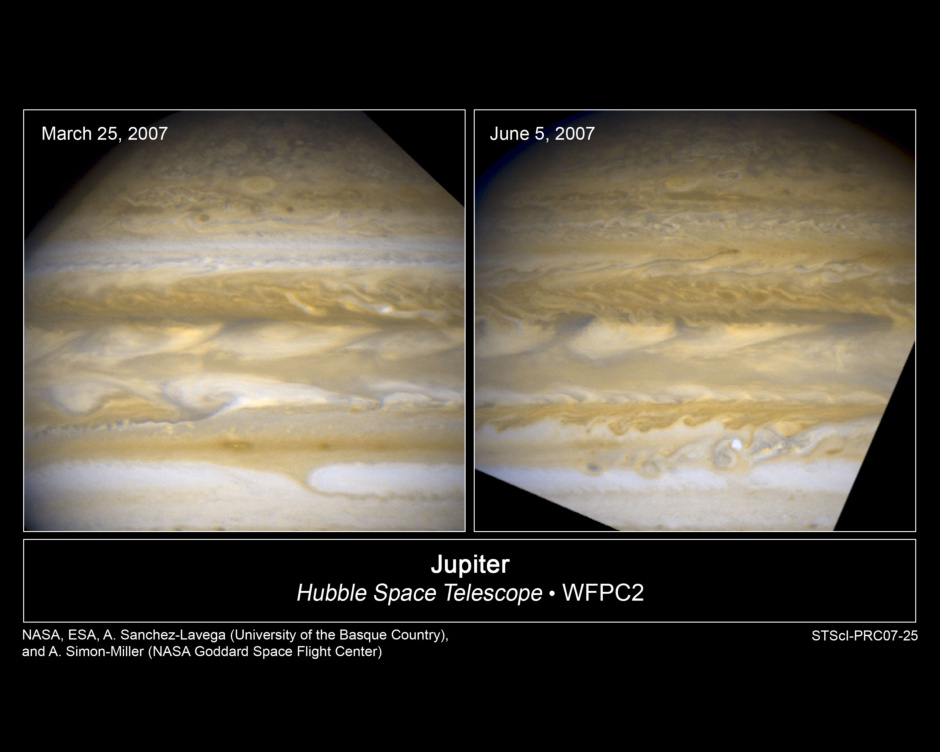거대한 목성에서 드라마틱한 대기 변화가 계속되고 있다.
이러한 광경은 허블 우주망원경이 있기 전에는 결코 볼 수 없었던 장면이다.
목성의 폭풍 구름은 이 행성 전체를 시속 수백 마일로 휩쓸면서 마치 대기상에서 장애물을 만난 것처럼 항상 변화하고 있다.
그런데 여기에 나타난 허블의 사진은 목성 전체의 구름들 중, 특히 적도 부근 구름들의 색채와 모양이 급격하게 변화하고 있음을 보여준다.
이 행성은 노란색, 갈색, 하얀색의 구름들로 완전히 덮혀있다.
이러한 구름들은 여러 위도에서 서로 다른 방향으로 치솟아오르는 대기에 의해서 만들어진다.
상승대기가 나타나는 밝은 부분은 'zone'이라 부르고, 하강대기가 발생하는 어두운 지역은 'belt'라고 부른다.
이처럼 상승기류와 하강기류의 상호영향으로 폭풍과 난기류가 발생한다.
지난 3월 25일과 6월 5일, 허블의 광대역 행성형 카메라 2(Wide Field and Planetary Camera 2, WFPC 2)는 전체 구름의 색채변이를 관찰하였다.
이 관찰에 따르면 'zone'은 'belt'로 이동하면서 어두워졌고, 'belt'는 'zone'으로 이동하면서 밝아졌다.
매우 빠른 속도로 구름의 모양과 크기가 변화했던 것이다.
<2007년 3월 25일 촬영된 목성대기>
<2007년 6월 5일 촬영된 목성대기>
3월 25일 촬영된 위쪽 이미지는 목성의 적도 위쪽에 얇은 밴드 모양의 하얀 구름들을 보여주고 있다.
이 하얀색은 이곳의 구름이 목성의 대기에서 매우 높은 곳에 있음을 말해준다.
그러나 6월 5일 촬영된 아래쪽 이미지에서는 이 하얀색들이 고동색으로 변했음을 알 수 있는데 이는 이 부분이 화성대기속으로 내려앉고 있음을 알려준다.
이로써 모든 구름층은 그 밑부분의 층과 뒤섞이고 있음을 보여준다.
위쪽 이미지에서 적도 위쪽에 나타나고 있는 작은 소용들이들은 아래쪽 사진에서는 커다란 파도 모양으로 변한것처럼 보인다.
대기에서 도드라지게 나타나는 검은 줄은 뱀을 닮았다.
여기 뱀처럼 생긴 구조는 실제로는 구름층에 나타난 작은 균열부로서 천문학자들은 여기를 통해 목성대기 깊숙이까지 바라다볼 수 있다.
적도 아래부분에서 윗부분이 짙은 갈색으로 되어 있는 상어 지느러미 모양은 아래 사진에서는 완전히 없어져 있다.
그 대신에 갈색 혀 모양의 구름들이 그 밑에 하얀색의 작은 소용돌이 구름들과 함께 나타나고 있다.
이러한 목성전역에서의 대기 변화는 이전에도 감지되었으나 허블의 고분해능으로는 이번에 처음 관측된 것이다.
1980년대에 천문학자들은 지상의 망원경을 이용하여 처음으로 목성의 격렬한 대기 변화를 엿보았다.
이후 1990년대 초반 허블이 설치되긴 했으나 당시 허블 망원경은 이러한 대기의 역전현상을 자세히 보여줄 수 있을만큼의 충분한 해상도를 가지고 있지 못했다.
여기에 등장한 이들 고해상도 허블 사진은 천문학자들이 목성에서 발생하고 있는 거대한 대기의 현상을 충분히 이해하도록 도와줄 것이다.
태양으로부터 목성공전궤도까지의 거리는 약 5.2AU이다.(7억 7천 8백만 킬로미터)
목성의 크기는 적도 부근에서의 직경이 약 14만 2984킬로미터이다.
* '허블사이트'의 게시물들은 허블사이트 http://hubblesite.org 의 뉴스센터 자료들을 번역한 자료들입니다.
본 내용은 2007년 7월 28일 발표된 뉴스입니다.
참고 : 목성대기의 다양한 풍경 등, 목성과 목성의 달에 대한 각종 포스팅은 아래 링크를 통해 조회할 수 있습니다.
https://big-crunch.tistory.com/12346946
원문>
Massive Jupiter is undergoing dramatic atmospheric changes that have never been seen before with the keen "eye" of NASA's Hubble Space Telescope.
Jupiter's turbulent clouds are always changing as they encounter atmospheric disturbances while sweeping around the planet at hundreds of miles per hour. But these Hubble images reveal a rapid transformation in the shape and color of Jupiter's clouds near the equator, marking an entire face of the globe.
The planet is wrapped in bands of yellows, browns, and whites. These bands are produced by the atmosphere flowing in different directions at various latitudes. Lighter-hued areas where the atmosphere rises are called zones. Darker regions where the atmosphere falls are called belts. When these opposing flows interact, storms and turbulence appear.
Between March 25 and June 5, Hubble's Wide Field and Planetary Camera 2 captured entire bands of clouds changing color. Zones have darkened into belts and belts have lightened and transformed into zones. Cloud features have rapidly altered in shape and size.
The image at left shows a thin band of white clouds above Jupiter's equator. The white color indicates clouds at higher altitudes in Jupiter's atmosphere. In the image at right, the band's white hue has turned brown, showing clouds deep within the planet's atmosphere. The whole band appears to have merged with the one below it.
In the same cloud band above the equator, the small swirls in the left-hand image have morphed into larger wave-like features in the right-hand photo. Dominating the band is a dark streak that resembles a snake. This serpent-shaped structure is actually a small tear in the cloud deck, which gives astronomers a view deep within the atmosphere.
Below the equatorial region, the brownish upside-down shark fin in the left-hand image disappears in the photo at right. Appearing instead are brownish tongue-shaped clouds with a stream of white swirls below them.
These global upheavals have been seen before, but not with Hubble's sharp resolution. Astronomers using ground-based telescopes first spied drastic atmospheric transformation in the 1980s. Another major disturbance was seen in the early 1990s, after Hubble was launched into space. The telescope, however, did not have the resolution to view the upheaval in fine detail. These higher-quality Hubble images may help astronomers understand how such global upheavals develop on Jupiter.
For additional information, contact:
Donna Weaver/Ray Villard
Space Telescope Science Institute, Baltimore, Md.
410-338-4493/4514; dweaver@stsci.edu/villard@stsci.edu
Dr. Amy Simon-Miller
NASA Goddard Space Flight Center, Greenbelt, Md.
301-286-6738; amy.simon@nasa.gov
Object Name: Jupiter
Image Type: Astronomical
Credit: NASA, ESA, A. Simon-Miller (NASA Goddard Space Flight Center), A. Sánchez-Lavega, R. Hueso, and S. Pérez-Hoyos (University of the Basque Country), E. García-Melendo (Esteve Duran Observatory Foundation, Spain), and G. Orton (Jet Propulsion Laboratory)
'3. 천문뉴스 > 허블사이트' 카테고리의 다른 글
| 에리스(Eris)와 위성 디스노미아(Dysnomia) (0) | 2007.09.22 |
|---|---|
| 소행성 세레스와 베스타 (0) | 2007.09.21 |
| 별들의 요람 NGC 4449 (0) | 2007.09.19 |
| 젊은 별과 암석부스러기 Disk (0) | 2007.09.19 |
| 별의 최후의 흔적(행성상성운) (0) | 2007.09.19 |


